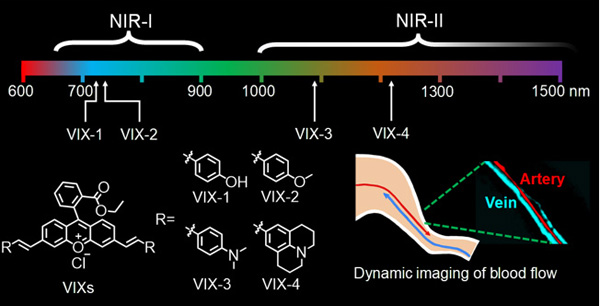Researchers propose the second near-infrared fluorophores for dynamic imaging of blood flow
Fluorescence bioimaging through the second near-infrared window (NIR-II, 1000-1700 nm) has attracted much attention due to its deep tissue penetration and high contrast. Organic small molecular fluorophores have presented satisfactory safety profiles. Currently, there are mainly two types of organic molecular NIR-II fluorophores, and each of them has its own drawbacks: the first type is the polymethines, which usually exhibit small Stokes shifts and poor stability; the second type is the benzo[1,2-c:4,5-c′]bis([1,2,5]thiadiazole) derivatives, whose brightness (molar absorption coefficient ? quantum yield) is rather limited. Therefore, developing new NIR-II fluorophores with high brightness is important but challenging.
Recently, a research team led by Prof. MA Huimin from the Institute of Chemistry, Chinese Academy of Sciences (ICCAS), reported a series of new xanthene-based NIR-II fluorophores (VIXs) by expanding π-conjugation and enhancing the intramolecular charge transfer effect. Among them, VIX-4 exhibited the best performance with fluorescence maximum emission at 1210 nm and high brightness and was used for dynamically imaging the blood flow of mice at 200 fps. By virtue of high spatiotemporal resolution of the dynamic imaging, the researchers can distinguish directly the artery and vein through the blood flow direction, and measure the blood flow volume with the videos. This study provides not only an effective tool for high spatial and temporal resolution bioimaging but also a new and promising conjugated skeleton for NIR-II spectroscopic probes.
The study entitled “Xanthene-Based NIR-II Dyes for In Vivo Dynamic Imaging of Blood Circulation” was published in J. Am. Chem. Soc.(2021, 143, 17136-17143). The research was supported by the National Natural Science Foundation of China and CAS.

The structures of new fluorophores VIXs and dynamic imaging of blood flow (image by Prof. SHI Wen and MA Huimin).
Contact:
Prof. SHI Wen and MA Huimin
Institute of Chemistry, Chinese Academy of Sciences
Email: shiwen@iccas.ac.cn; mahm@iccas.ac.cn





